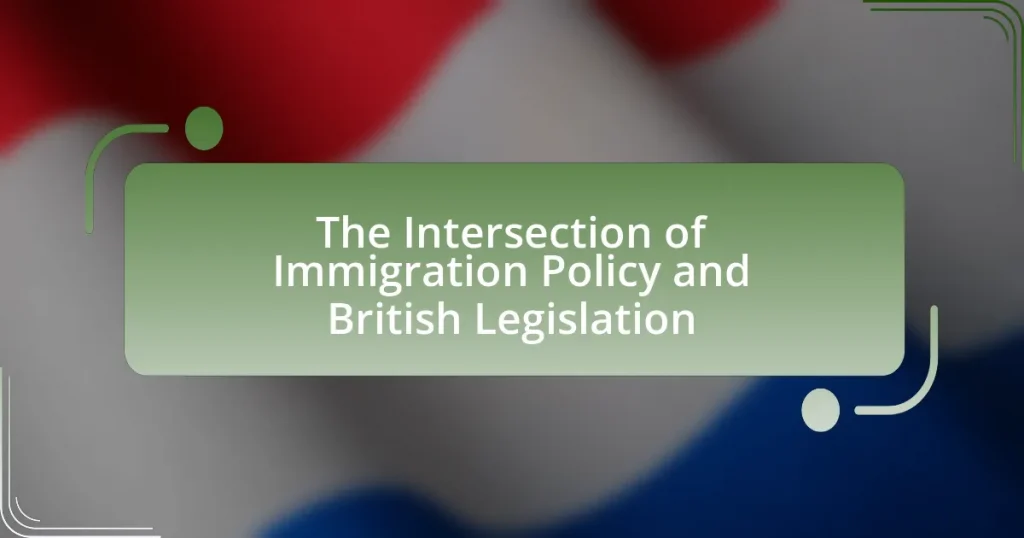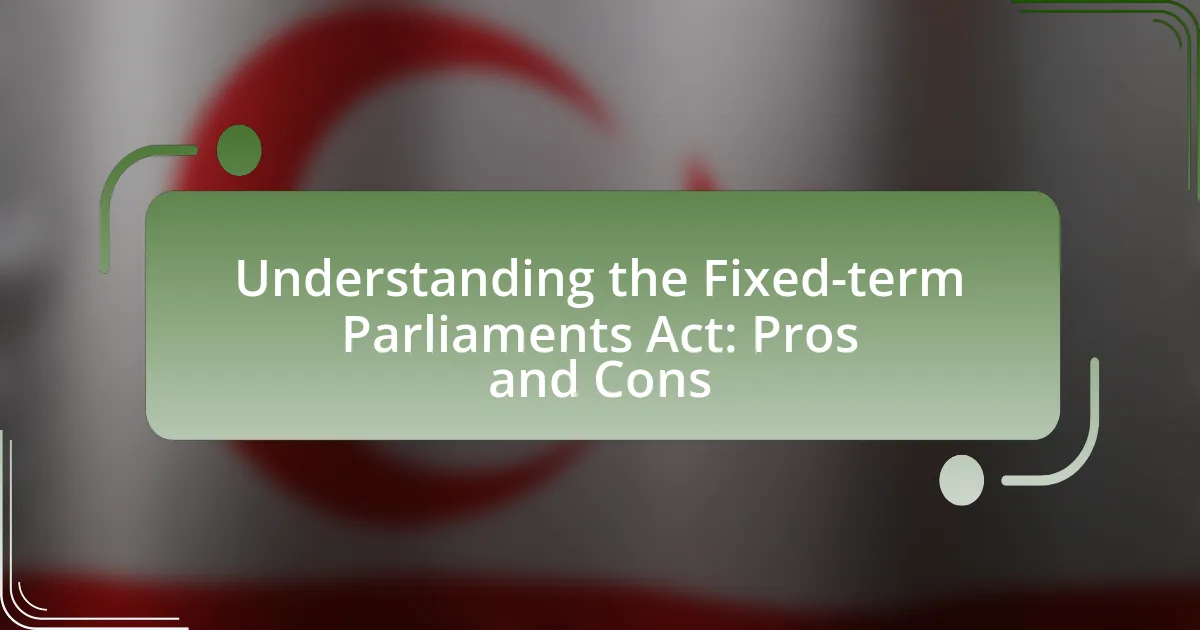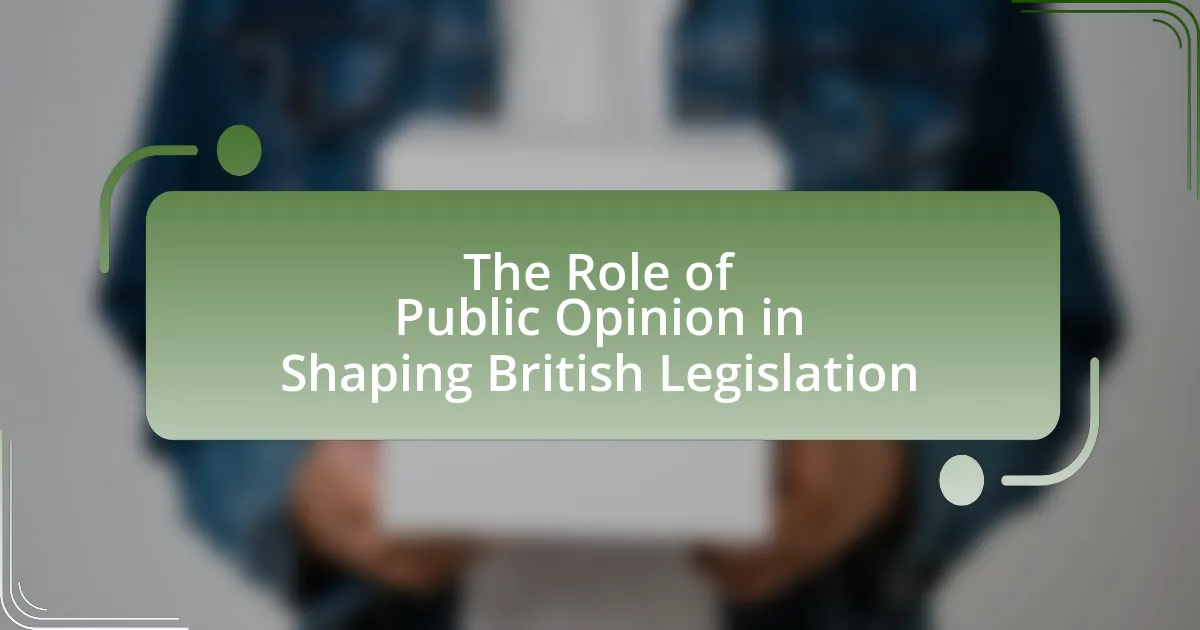The article examines the intersection of immigration policy and British legislation, detailing how laws such as the Immigration Act 1971 and the Nationality and Borders Act 2022 shape immigration control in the UK. It explores the influence of immigration policies on legislation regarding citizenship, labor rights, and social services, as well as the historical events that have shaped these policies. The article also addresses the challenges arising from legal inconsistencies, human rights concerns, and public opinion, while highlighting the implications of recent legislative changes, including the points-based immigration system post-Brexit. Additionally, it discusses the economic and social impacts of immigration policies on society and public services, emphasizing the need for effective and balanced immigration frameworks.
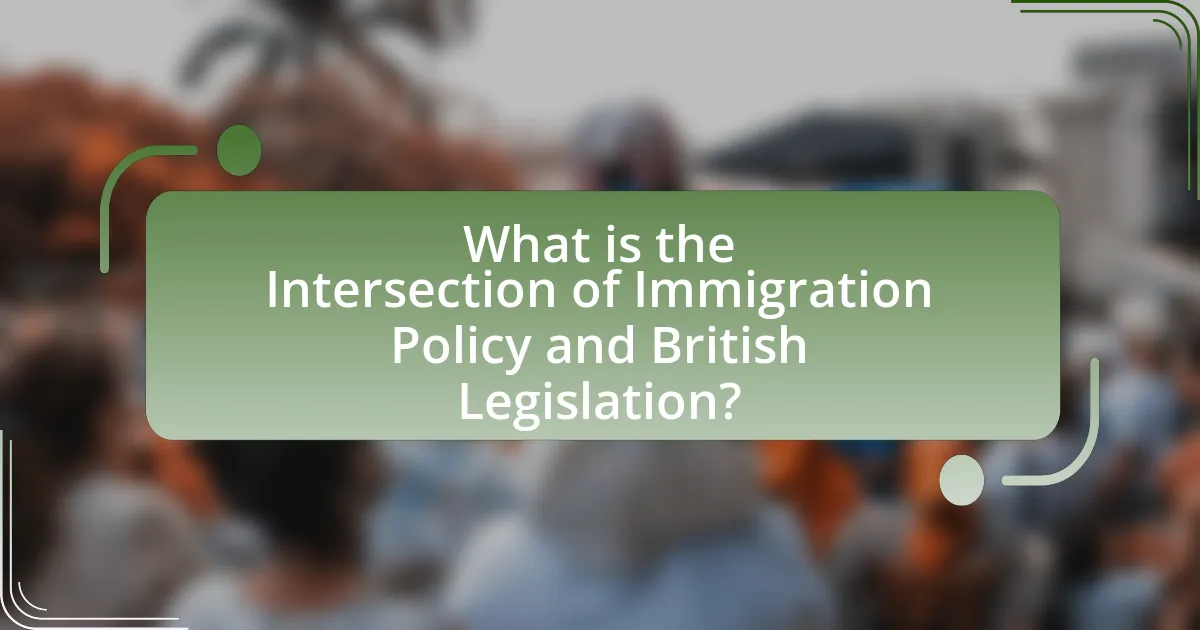
What is the Intersection of Immigration Policy and British Legislation?
The intersection of immigration policy and British legislation refers to the ways in which laws governing immigration are shaped, implemented, and enforced within the framework of the UK’s legal system. British legislation, such as the Immigration Act 1971 and the more recent Nationality and Borders Act 2022, establishes the legal parameters for immigration control, including visa requirements, asylum processes, and the rights of migrants. These laws are influenced by various factors, including international treaties, public opinion, and political considerations, which collectively determine how immigration policy is formulated and executed in the UK.
How do immigration policies influence British legislation?
Immigration policies significantly influence British legislation by shaping laws related to citizenship, labor rights, and social services. For instance, the Immigration Act 2016 introduced measures that affected the rights of EU citizens and non-EU migrants, leading to changes in employment law and access to public services. Additionally, the ongoing debates surrounding Brexit have prompted legislative adjustments to immigration rules, impacting the legal framework governing the movement of people and their rights within the UK. These policies directly affect how laws are formulated, amended, and enforced, reflecting the government’s stance on immigration and its socio-economic implications.
What are the key components of immigration policy in the UK?
The key components of immigration policy in the UK include visa regulations, asylum processes, border control measures, and pathways to citizenship. Visa regulations dictate the criteria for entry and stay, including work, study, and family reunification visas. The asylum process outlines how individuals can seek protection from persecution, with specific procedures for application and appeal. Border control measures involve the enforcement of immigration laws at entry points, including checks and enforcement actions against illegal immigration. Pathways to citizenship provide routes for immigrants to obtain permanent residency and citizenship, often requiring a period of lawful residence and knowledge of the English language. These components are shaped by legislation such as the Immigration Act 1971 and the Nationality Act 1981, which establish the legal framework for immigration control in the UK.
How does British legislation respond to changes in immigration policy?
British legislation adapts to changes in immigration policy through the introduction of new laws and amendments to existing statutes. For instance, the Immigration Act 2016 and the Immigration Control (Gross Human Rights Abuses) Act 2019 were enacted to address evolving immigration challenges and to implement stricter controls. These legislative changes reflect the government’s response to public sentiment and political pressures regarding immigration, demonstrating a direct correlation between policy shifts and legislative action.
Why is the intersection of these two areas significant?
The intersection of immigration policy and British legislation is significant because it shapes the legal framework governing the rights and responsibilities of immigrants in the UK. This intersection influences how laws are enacted, interpreted, and enforced, impacting the lives of millions. For instance, the Immigration Act 2016 introduced measures that affect the ability of immigrants to access public services, demonstrating the direct consequences of legislative decisions on immigration policy. Additionally, the interplay between these areas can lead to legal challenges that test the balance between national security and human rights, as seen in cases brought before the UK courts regarding the legality of detention practices.
What historical events have shaped immigration policy in Britain?
The historical events that have shaped immigration policy in Britain include the 1905 Aliens Act, the post-World War II influx of immigrants from the Commonwealth, and the 1971 Immigration Act. The 1905 Aliens Act marked the first significant legislation aimed at controlling immigration, primarily targeting Jewish refugees. Following World War II, Britain saw a substantial increase in immigration from Commonwealth countries, driven by labor shortages and the need for reconstruction, which led to the 1962 Commonwealth Immigrants Act that restricted immigration based on nationality. The 1971 Immigration Act further tightened controls, introducing a system that favored those with British ancestry. These events collectively reflect the evolving attitudes and legislative responses to immigration in Britain.
How do public opinions on immigration affect legislative changes?
Public opinions on immigration significantly influence legislative changes by shaping policymakers’ agendas and decisions. When a substantial portion of the public expresses concern or support for immigration policies, legislators often respond by proposing or modifying laws to align with these sentiments. For instance, in the UK, the 2016 Brexit referendum demonstrated how public opinion on immigration directly impacted legislative direction, leading to a commitment to reduce immigration levels as part of the exit strategy from the European Union. This shift was reflected in subsequent immigration legislation aimed at controlling the flow of migrants, illustrating the direct correlation between public sentiment and legislative action.
What challenges arise at the intersection of immigration policy and British legislation?
Challenges at the intersection of immigration policy and British legislation include legal inconsistencies, enforcement difficulties, and human rights concerns. Legal inconsistencies arise when immigration laws conflict with existing statutes, leading to confusion and potential violations of rights. Enforcement difficulties stem from the complexity of immigration regulations, which can hinder effective implementation and compliance. Human rights concerns are prevalent, particularly regarding the treatment of asylum seekers and undocumented migrants, as legislation may not adequately protect their rights, leading to potential breaches of international obligations. These challenges highlight the need for coherent policies that align with both legal frameworks and humanitarian principles.
What legal conflicts have emerged from immigration policies?
Legal conflicts that have emerged from immigration policies include challenges to the legality of detention practices, the enforcement of deportation orders, and the interpretation of asylum laws. For instance, the UK Supreme Court ruled in 2019 that the Home Office’s policy of detaining individuals without a time limit was unlawful, highlighting issues of human rights and due process. Additionally, various cases have arisen regarding the legality of the “hostile environment” policy, which has faced criticism for leading to discrimination against certain immigrant groups. These conflicts illustrate the tension between immigration enforcement and legal protections afforded to individuals under British law.
How do human rights considerations impact immigration legislation?
Human rights considerations significantly impact immigration legislation by ensuring that laws align with international human rights standards. For instance, the UK is a signatory to the European Convention on Human Rights, which mandates the protection of individuals from inhumane treatment and guarantees the right to family life. This legal framework influences immigration policies, compelling lawmakers to consider the rights of asylum seekers and migrants, particularly in areas such as detention conditions and deportation processes. Additionally, the UK courts have ruled that immigration decisions must take into account the potential human rights implications, reinforcing the necessity for legislation that respects the dignity and rights of all individuals, regardless of their immigration status.
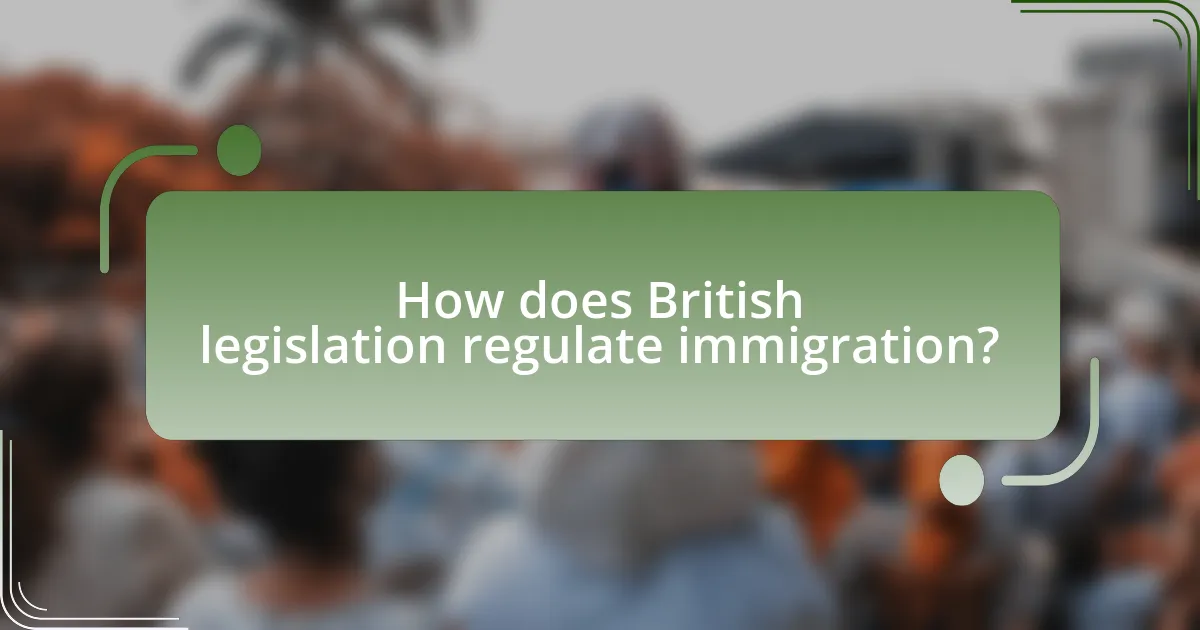
How does British legislation regulate immigration?
British legislation regulates immigration primarily through the Immigration Act 1971 and subsequent amendments, which establish the legal framework for entry, stay, and removal of non-UK nationals. This legislation outlines various visa categories, eligibility criteria, and enforcement mechanisms, including the powers of immigration officers to detain and remove individuals who do not comply with immigration rules. Additionally, the UK has implemented the Points-Based System, introduced in 2021, which assesses applicants based on skills, salary, and language proficiency, ensuring that immigration aligns with the country’s economic needs. These laws are enforced by the Home Office, which oversees immigration control and policy implementation.
What are the main laws governing immigration in the UK?
The main laws governing immigration in the UK include the Immigration Act 1971, the Nationality Act 1981, the Immigration (European Economic Area) Regulations 2016, and the Immigration Control (Gross Human Rights Abuses) Act 2019. The Immigration Act 1971 established the framework for immigration control and set out the rights of individuals to enter and remain in the UK. The Nationality Act 1981 defined British citizenship and the rights associated with it. The Immigration (European Economic Area) Regulations 2016 implemented the rights of EU citizens to live and work in the UK, reflecting the UK’s obligations under EU law prior to Brexit. The Immigration Control (Gross Human Rights Abuses) Act 2019 allows the UK to impose sanctions on individuals involved in serious human rights abuses, impacting their ability to enter the country. These laws collectively shape the UK’s immigration policy and its enforcement mechanisms.
How do these laws vary between different regions of the UK?
Immigration laws in the UK vary significantly between England, Scotland, Wales, and Northern Ireland. Each region has its own legislative powers and frameworks that influence immigration policy. For instance, Scotland has the ability to tailor its immigration policies to address specific demographic needs, such as attracting skilled workers to counteract population decline, which is distinct from the more centralized approach taken in England. Additionally, Wales has implemented policies aimed at promoting inclusivity and community cohesion, while Northern Ireland’s immigration laws are influenced by its unique political context and agreements, such as the Good Friday Agreement. These regional variations reflect the devolved nature of governance in the UK, allowing for localized responses to immigration challenges.
What role do international agreements play in British immigration law?
International agreements significantly influence British immigration law by establishing legal frameworks that govern the treatment of migrants and refugees. These agreements, such as the 1951 Refugee Convention and various bilateral treaties, obligate the UK to adhere to specific standards regarding asylum seekers and the rights of individuals. For instance, the UK is required to assess asylum claims fairly and not to return individuals to countries where they may face persecution, as stipulated in the Refugee Convention. This legal obligation shapes domestic policies and procedures, ensuring compliance with international human rights standards.
What recent changes have been made to immigration legislation?
Recent changes to immigration legislation in the UK include the introduction of the Illegal Migration Act 2023, which aims to deter illegal entry into the country by allowing for the detention and removal of individuals who arrive unlawfully. This legislation also establishes a framework for the expedited processing of asylum claims and restricts the ability of individuals to challenge their removal in court. The act reflects the government’s commitment to reducing illegal immigration and enhancing border security, as evidenced by the increase in enforcement measures and the prioritization of legal pathways for migration.
How has Brexit affected immigration policies and laws?
Brexit has significantly altered immigration policies and laws in the United Kingdom by ending the free movement of people between the UK and EU member states. This change was formalized with the introduction of the new points-based immigration system on January 1, 2021, which prioritizes skilled workers and requires applicants to meet specific criteria, such as job offers and minimum salary thresholds. The UK government aimed to reduce low-skilled immigration and shift towards a system that attracts talent based on skills rather than nationality, as evidenced by the Home Office’s statistics showing a decrease in EU nationals applying for settled status post-Brexit.
What are the implications of the new points-based immigration system?
The new points-based immigration system in the UK primarily aims to attract skilled workers while reducing overall immigration numbers. This system assigns points based on specific criteria such as job offers, skill levels, and English language proficiency, which means that only those meeting the required thresholds can enter the country for work. The implications include a potential decrease in low-skilled labor availability, impacting sectors like agriculture and hospitality that traditionally relied on such workers. Additionally, the system may lead to a more competitive labor market for skilled positions, as employers must navigate the new requirements to hire foreign talent. The changes reflect a shift towards prioritizing high-skilled immigration, aligning with the UK government’s goal to enhance the economy and workforce productivity.
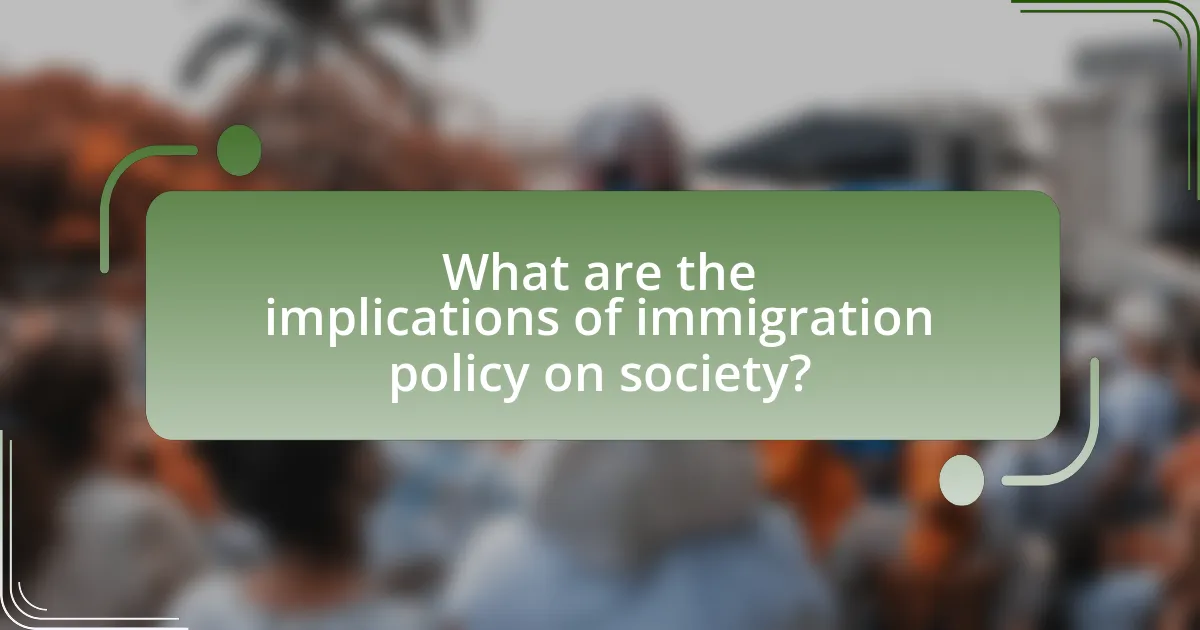
What are the implications of immigration policy on society?
Immigration policy significantly impacts society by influencing demographic composition, economic growth, and social cohesion. For instance, policies that facilitate immigration can lead to a more diverse population, which can enhance cultural exchange and innovation. According to a report by the Migration Advisory Committee in the UK, immigrants contributed approximately £2.5 billion to the economy in 2019, highlighting their role in economic expansion. Conversely, restrictive immigration policies can result in labor shortages, particularly in sectors reliant on migrant workers, such as agriculture and healthcare. Furthermore, immigration policy shapes public perceptions and attitudes towards immigrants, which can either foster inclusivity or exacerbate social tensions. Research from the Pew Research Center indicates that countries with more welcoming immigration policies tend to experience lower levels of xenophobia and social conflict. Thus, the implications of immigration policy on society are profound, affecting economic vitality, cultural dynamics, and social harmony.
How does immigration policy impact the economy?
Immigration policy significantly impacts the economy by influencing labor supply, consumer demand, and overall economic growth. For instance, policies that facilitate immigration can lead to an increase in the workforce, which helps fill labor shortages in various sectors, such as healthcare and technology. According to a report by the Migration Advisory Committee, immigrants contributed approximately £2.5 billion to the UK economy in 2019 through taxes and spending. Furthermore, diverse immigrant populations can enhance innovation and entrepreneurship, as evidenced by the fact that nearly half of UK startups valued at over $1 billion have at least one immigrant founder. Thus, effective immigration policies can drive economic expansion and improve productivity.
What sectors of the economy are most affected by immigration?
The sectors of the economy most affected by immigration include agriculture, construction, hospitality, and healthcare. These industries rely heavily on immigrant labor to fill low-skilled positions that are often difficult to staff with native workers. For instance, the UK agricultural sector employs a significant number of seasonal migrant workers, with estimates indicating that around 60% of the workforce in this sector is comprised of immigrants. In construction, immigrants make up a substantial portion of the labor force, contributing to the completion of projects and addressing labor shortages. The hospitality industry also depends on immigrant workers for roles such as chefs and service staff, while healthcare increasingly relies on foreign-trained professionals to meet demand, particularly in nursing and caregiving roles.
How do immigration policies influence labor market dynamics?
Immigration policies significantly influence labor market dynamics by determining the flow of workers into a country, which affects labor supply and demand. For instance, restrictive immigration policies can lead to labor shortages in key sectors such as healthcare and agriculture, where demand for workers often exceeds the local supply. Conversely, more open immigration policies can enhance labor market flexibility, allowing businesses to fill vacancies and adapt to changing economic conditions. Research from the Migration Advisory Committee in the UK indicates that a 10% increase in immigration can lead to a 0.5% increase in GDP, highlighting the positive economic impact of immigration on labor markets.
What social implications arise from immigration legislation?
Immigration legislation significantly impacts social dynamics within a country. It can lead to increased diversity, fostering multiculturalism, but may also result in social tension and division among different communities. For instance, the introduction of stricter immigration laws in the UK has been linked to rising xenophobia and anti-immigrant sentiments, as evidenced by the increase in hate crimes reported following the Brexit referendum in 2016. Additionally, immigration policies can affect access to social services, education, and employment opportunities for immigrants, influencing their integration into society. Studies show that inclusive immigration policies tend to promote social cohesion, while restrictive measures can exacerbate social inequalities and marginalization.
How do immigration policies affect community integration?
Immigration policies significantly influence community integration by determining the legal status, rights, and resources available to immigrants. For instance, policies that provide pathways to citizenship and access to social services facilitate greater participation in community life, fostering social cohesion. Conversely, restrictive immigration policies can lead to marginalization, limiting immigrants’ ability to engage with local communities and access essential services. Research by the Migration Policy Institute indicates that inclusive immigration policies correlate with higher rates of community involvement and economic contributions from immigrants, demonstrating the positive impact of supportive frameworks on integration outcomes.
What are the effects of immigration on public services?
Immigration significantly impacts public services by increasing demand for healthcare, education, and housing. For instance, the National Health Service (NHS) in the UK has reported that an influx of immigrants can lead to longer waiting times and increased pressure on resources, as seen during the 2015 refugee crisis when NHS services experienced heightened demand. Additionally, schools often face challenges in accommodating non-native English speakers, which can strain educational resources and require additional funding for language support programs. Furthermore, local governments may encounter difficulties in providing adequate housing, leading to overcrowding and increased homelessness rates. These effects illustrate the complex relationship between immigration and the capacity of public services to meet the needs of both immigrants and the existing population.
What best practices can be adopted for effective immigration policy?
Effective immigration policy can be achieved through comprehensive stakeholder engagement, data-driven decision-making, and streamlined processes. Engaging various stakeholders, including community organizations, businesses, and immigrants themselves, ensures that policies reflect the needs and realities of all parties involved. Data-driven decision-making, supported by research from institutions like the Migration Observatory, highlights the importance of using accurate demographic and economic data to inform policy choices. Streamlined processes, such as simplifying application procedures and reducing wait times, enhance efficiency and improve the overall experience for immigrants, as evidenced by successful models in countries like Canada, which has implemented a points-based system to attract skilled workers efficiently.
How can policymakers balance immigration control with humanitarian needs?
Policymakers can balance immigration control with humanitarian needs by implementing a framework that prioritizes both security and compassion. This can be achieved through the establishment of clear, fair immigration processes that allow for the assessment of humanitarian claims while maintaining border security. For instance, the UK has provisions under the Refugee Convention, which obligates the country to protect individuals fleeing persecution, thus integrating humanitarian considerations into immigration policy. Additionally, data from the Home Office indicates that a structured approach to asylum applications can lead to efficient processing times, allowing for both the enforcement of immigration laws and the provision of necessary support to vulnerable populations.
What role can public engagement play in shaping immigration legislation?
Public engagement plays a crucial role in shaping immigration legislation by influencing policymakers through public opinion and advocacy. When citizens actively participate in discussions, campaigns, and forums regarding immigration, they can raise awareness about specific issues, such as the economic contributions of immigrants or the humanitarian aspects of asylum policies. For instance, public protests and petitions have historically led to significant legislative changes, such as the 2016 public outcry that contributed to the reconsideration of the Immigration Act in the UK. This demonstrates that when the public mobilizes, it can effectively impact the legislative process and encourage lawmakers to consider diverse perspectives and needs in immigration policy.
